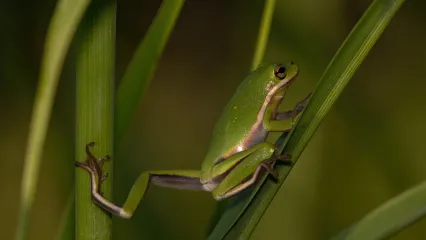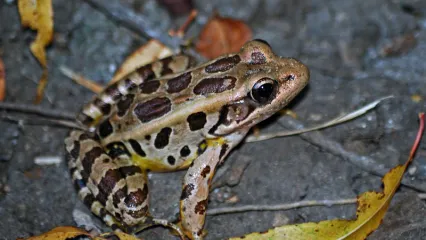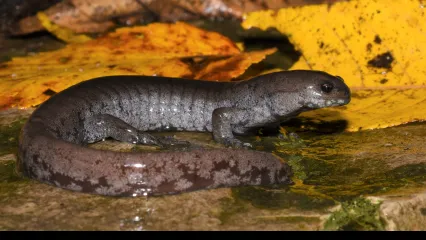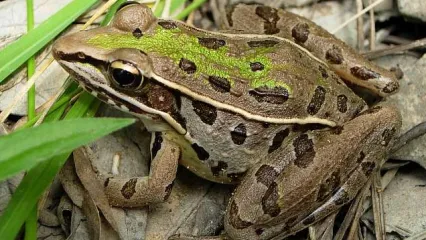
Description
The green treefrog is one of Oklahoma’s most distinctive frogs. This moderately large treefrog has a slender body and smooth skin that is bright green. Another distinctive feature is a white or light yellow lateral line outlined in gray that extends from below the eye to the groin. Although typically bright green at night, this frog may become pale yellow-green at other times. In some specimens, the dorsum may have a few tiny scattered bright yellow spots. The venter is white, and the eye is golden with a dark brown horizontal streak. Like other treefrogs, this species has large toe pads.
Tadpoles of the green treefrog can reach 1.5 to 2 inches before transforming into froglets. The body is dark greenish-brown with greenish mottling and lighter yellow-brown tail fins. A distinctive light yellow line extends from the nostril to the eye. The eyes are golden. Green treefrog tadpoles require about 4 to 6 weeks to metamorphose.
The call of the green treefrog is a loud honking or cowbell sound. The latter description of the call leads to their alternate name, bell treefrog. The call is very loud, and a large chorus can be deafening. Choruses can be heard from a long distance.
Size
Adults range in size from 1.25 to 2.5 inches in length. Females are slightly larger than males. Newly metamorphosed juveniles are about 1.25 inches in length.
Habitat
The distribution of this species in Oklahoma is disjunct. In the southeastern part of the state, their distribution is associated with the Red River drainage. However, further north along the eastern border of the state and slightly to the west, their distribution appears to be associated with the Arkansas River. Several apparently disjunct populations have been located in this region, including an isolated population in Tulsa. Within the U.S., these frogs occur in the deep south, with some populations occurring as far north as Missouri, Illinois, and Maryland.
Life Cycle
Green treefrogs are late spring to summer breeders. In places where they are common, their calls can be heard throughout the summer, often into August if some rainfall occurs. These frogs prefer permanent water bodies as breeding sites. Although many frogs avoid bodies of water with fish, these frogs breed in many sites where fish are present, including permanent ponds, lake edges, swamps, and marshes. They are frequently reported from fish-farm ponds. Individuals call from perches in aquatic vegetation along the shoreline or from large lilypads or other vegetation in deep water. Individual females may deposit up to 3,000 eggs.
Green treefrogs feed on small insects and spiders.
How To Observe
Green treefrogs are not difficult to observe. During the day in warm months, they take refuge on or in vegetation or in other crevices. Individuals take a water-conserving pose during the day, with their legs tightly pressed against the body and the body pressed against a substrate, such as a leaf. They may be in full view on vegetation during the day, but because their bright green coloration matches the vegetation, they can be difficult to locate. At night around breeding sites, they are very conspicuous because of their loud calls and their choice of conspicuous calling sites. In rural areas, they may frequently be seen on windows of houses at night, where they search for insects drawn to lights.
(This profile was created by Dr. Laurie Vitt as part of a partnership between the Wildlife Department and the Sam Noble Oklahoma Museum of Natural History. It was funded as part of a larger State Wildlife Grant to survey and inventory amphibians and reptiles of the Wildlife Management Areas of Oklahoma: T-35-P-1.)


